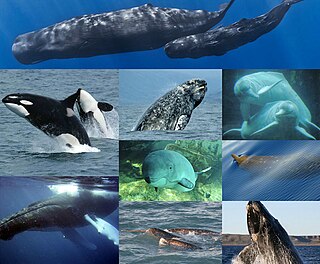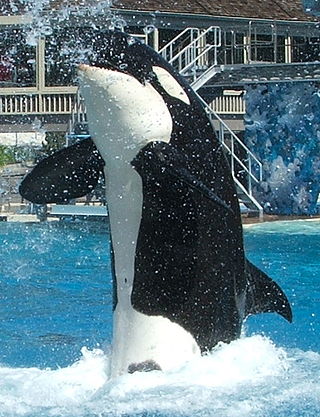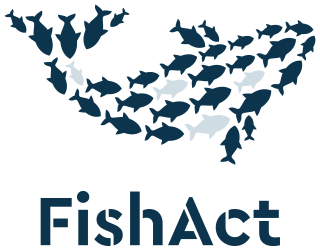
Cetacea is an infraorder of aquatic mammals that includes whales, dolphins, and porpoises. Key characteristics are their fully aquatic lifestyle, streamlined body shape, often large size and exclusively carnivorous diet. They propel themselves through the water with powerful up-and-down movement of their tail which ends in a paddle-like fluke, using their flipper-shaped forelimbs to maneuver.

The orca or killer whale is a toothed whale belonging to the oceanic dolphin family, of which it is the largest member. It is the only extant species in the genus Orcinus and is recognizable by its black-and-white patterned body. A cosmopolitan species, orcas can be found in all of the world's oceans in a variety of marine environments, from Arctic and Antarctic regions to tropical seas.

Whale watching is the practice of observing whales and dolphins (cetaceans) in their natural habitat. Whale watching is mostly a recreational activity, but it can also serve scientific and/or educational purposes. A study prepared for International Fund for Animal Welfare in 2009 estimated that 13 million people went whale watching globally in 2008. Whale watching generates $2.1 billion per annum in tourism revenue worldwide, employing around 13,000 workers. The size and rapid growth of the industry has led to complex and continuing debates with the whaling industry about the best use of whales as a natural resource.

SeaWorld is an American theme park chain with headquarters in Orlando, Florida. It is a proprietor of marine mammal parks, oceanariums, animal theme parks, and rehabilitation centers owned by SeaWorld Parks & Entertainment. The parks feature orcas, sea lion, and dolphin shows and zoological displays featuring various other marine animals.

A dolphinarium is an aquarium for dolphins. The dolphins are usually kept in a pool, though occasionally they may be kept in pens in the open sea, either for research or public performances. Some dolphinariums consist of one pool where dolphins perform for the public, others are part of larger parks, such as marine mammal parks, zoos or theme parks, with other animals and attractions as well.

Cetology or whalelore is the branch of marine mammal science that studies the approximately eighty species of whales, dolphins, and porpoises in the scientific order Cetacea. Cetologists, or those who practice cetology, seek to understand and explain cetacean evolution, distribution, morphology, behavior, community dynamics, and other topics.

Loro Parque or 'Loro Park' is a 135,000 m² zoo on the outskirts of Puerto de la Cruz on Tenerife, Spain where it houses an extensive and diverse reserve of animal and plant species. The park was conceived as a paradise for parrots and has developed over the years into one of the biggest attractions of the Canary Islands, with over 40 million visitors.

Dolphin drive hunting, also called dolphin drive fishing, is a method of hunting dolphins and occasionally other small cetaceans by driving them together with boats and then usually into a bay or onto a beach. Their escape is prevented by closing off the route to the open sea or ocean with boats and nets. Dolphins are hunted this way in several places around the world including the Solomon Islands, the Faroe Islands, Peru, and Japan which is the most well-known practitioner of the method. In large numbers dolphins are mostly hunted for their meat; some end up in dolphinariums.

The Marineland of Antibes is a theme park founded in 1970 by Roland de La Poype in Antibes (Alpes-Maritimes), in the French Riviera. On 26 hectares it includes a marine zoological park with dolphinarium, a water park (Aquasplash), a children's play park, mini golf and a three-star hotel. It is the property of the Spanish multinational company Parques Reunidos, whose majority shareholder is the British investment fund Arle Capital Partners. The current director is Arnaud Palu.
Orcas are large, powerful apex predators. In the wild, there have been no reliably verified fatal attacks on humans. In captivity, there have been several non-fatal and four fatal attacks on humans since the 1970s. Experts are divided as to whether the injuries and deaths were accidental or deliberate attempts to cause harm.

A number of orcas, also called killer whales, are held in captivity by humans for breeding or performance purposes. The practice of capturing and displaying orcas in exhibitions began in the 1960s, and they soon became popular attractions at public aquariums and aquatic theme parks due to their intelligence, trainability, striking appearance, playfulness, and sheer size. As of August 19, 2021, there were 57 orcas in captivity worldwide, 30 of which were captive-born. At that time, there were 19 orcas in the SeaWorld parks.

Dawn Therese Brancheau was an American senior animal trainer at SeaWorld. She worked with orcas at SeaWorld Orlando for fifteen years, including a leading role in revamping the Shamu show, and was SeaWorld's poster girl. She was killed by an orca, Tilikum. Tilikum was also involved in the deaths of two other people: Keltie Byrne and Daniel P. Dukes.

Tilikum, nicknamed Tilly, was a captive male orca who spent most of his life at SeaWorld Orlando in Florida. He was captured in Iceland in 1983; about a year later, he was transferred to Sealand of the Pacific in Victoria, British Columbia. He was subsequently transferred in 1992 to SeaWorld in Orlando, Florida, where he sired 21 calves throughout his life.

Morgan is a female orca who was rescued in the Wadden Sea, off the northwestern coast of the Netherlands in June 2010. She was found in an unhealthy condition, severely underweight and malnourished. She lived several months at the Dolfinarium Harderwijk in the Netherlands. After it became clear that the basin at Dolfinarium was too small, multiple options were considered, including releasing Morgan and transferring her to another facility. Over a year later, after litigation and debate between scientists, a Dutch court ruled that she was to be moved. Morgan was transported to the Loro Parque in Spain in November 2011.

FishAct is an international marine conservation and activism organisation based in Amsterdam, Netherlands. Its name was changed in 2018 to FishAct. FishAct's stated mission is to "end the industrial overfishing of the oceans" and to "empower individuals to get actively involved in building grassroots citizen-led conservation communities". The non-governmental organisation was founded in 2010 and has active local chapters in Germany and the United Kingdom. To achieve its goals, the organisation uses a combination of investigation, education, and non-violent direct-action. Campaigns have included gathering support for the release of captive cetaceans, actions against dolphin drive hunts and campaigning to end overfishing of the endangered bluefin tuna in the Mediterranean Sea.
Erich Hoyt is a whale and dolphin (cetacean) researcher, conservationist, lecturer and author of 26 books and more than 700 reports, articles and papers. His book Marine Protected Areas for Whales, Dolphins and Porpoises, has been widely reviewed as the "definitive reference of the current extent of cetacean ecosystems-based management" and as "a unique and essential book for anybody interested in the conservation and protection of cetaceans. [This] definitive source on MPAs marine protected areas for cetaceans…will influence the design and management of this important and rapidly developing conservation tool." Choice listed the book as an "Outstanding Academic Title’ for the year 2012. Since 2013, as Research Fellow with Whale and Dolphin Conservation (WDC) and IUCN SSC/WCPA Marine Mammal Protected Areas Task Force co-chair with Giuseppe Notarbartolo di Sciara, Hoyt has focussed on the creation and development of the new conservation tool of Important Marine Mammal Areas, or IMMAs. In 2016, following a MAVA Foundation pilot project to identify IMMAs in the Mediterranean, the Task Force's GOBI collaboration funded by the German Climate Initiative (IKI) began a six-year project to identify and implement IMMAs across most of the southern hemisphere. The IMMA tool has been received and widely endorsed by the Convention on Migratory Species (CMS), the Convention on Biological Diversity (CBD), various commissions within the International Union for Conservation of Nature (IUCN), the International Whaling Commission, as well as national governments and scientists.
Alexis Martínez was an orca trainer at Loro Parque’s Orca Ocean in the Canary Islands, who was killed by a SeaWorld-owned orca, Keto.

The Free Morgan Foundation is a non-profit charity that advocates the release of Morgan, a female orca held at Loro Parque in Tenerife, Canary Islands. The foundation is made up of a number of independent international experts representing numerous orca research and education organisations, including Orcalab, Orca Network, Orca Research Trust, Centre for Whale Research, and Project SeaWolf Coastal Protection.


















